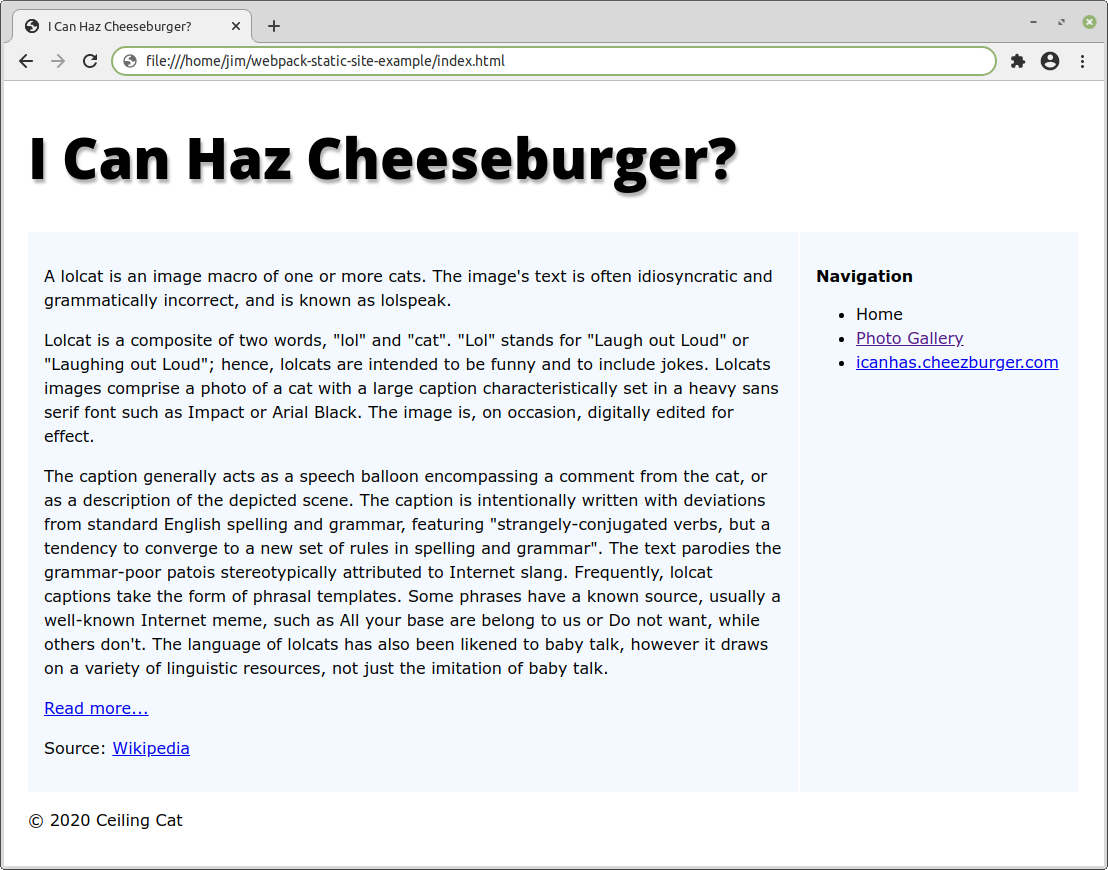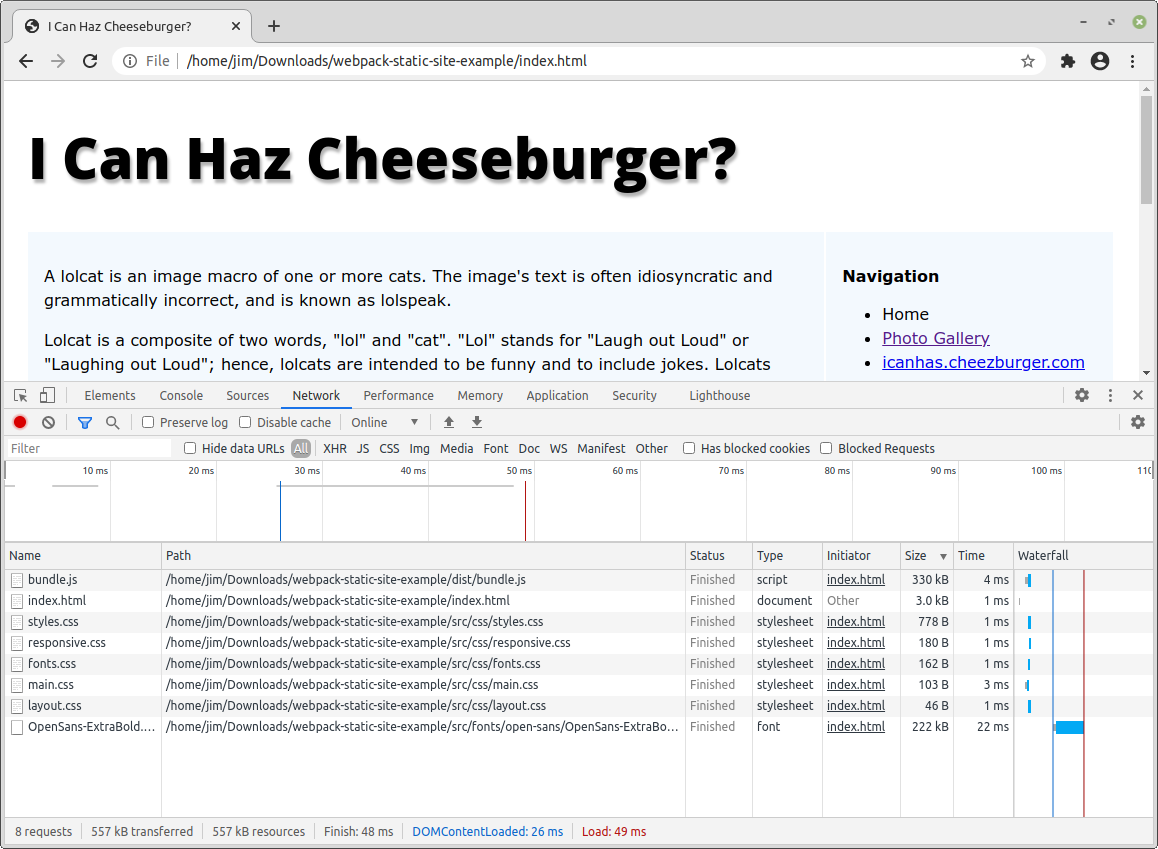Webpack has established itself as an indispensable part of the JavaScript toolchain. It has over 55,000 stars on GitHub and is used by many of the big players in the JavaScript world, such as React and Angular.
However, you don’t need to be using a front-end framework, or be working on a large-scale project to take advantage of it. Webpack is primarily a bundler, and as such you can also use it to bundle just about any resource or asset you care to think of.
In this article, I’m going to show you how to install and configure webpack, then use it to create minified bundles for a simple static site with a handful of assets.
But Why Would You Want to Do That?
Good question. Glad you asked!
One of the reasons for doing this is to minimize the number of HTTP requests you make to the server. As the average web page grows, you’ll likely include jQuery (yes, it’s still popular in 2020), a couple of fonts, a few plugins, as well as various style sheets and some JavaScript of your own. If you’re making a network request for each of these assets, things soon add up and your page can become sluggish. Bundling your code can go some way to mitigating this problem.
Webpack also makes it easy to minify your code, further reducing its size, and it lets you write your assets in whatever flavor you desire. For example, in this article I’ll demonstrate how to have webpack transpile modern JavaScript to ES5. This means you can write JavaScript using the latest, most up-to-date syntax (although this might not be fully supported yet), then serve the browsers ES5 that will run almost everywhere.
And finally, it’s a fun learning exercise. Whether or not you employ any of these techniques in your own projects is down to you, but by following along you’ll get a firm understanding of what webpack does, how it does it and whether it’s a good fit for you.
Getting up and Running
The first thing you’ll need is to have Node and npm installed on your computer. If you haven’t got Node yet, you can either download it from the Node website, or you can download and install it with the aid of a version manager. Personally, I much prefer this second method, as it allows you to switch between multiple versions of Node and it negates a bunch of permissions errors, which might otherwise see you installing Node packages with admin rights.
We’ll also need a skeleton project to work with. Here’s one I made earlier. To get it running on your machine, you should clone the project from GitHub and install the dependencies:
git clone https://github.com/sitepoint-editors/webpack-static-site-example
cd webpack-static-site-example
npm install
This will install jQuery, plus Slick Slider and Lightbox2 — two plugins we’ll be using on the site — to a node_modules folder in the root of the project.
After that, you can open index.html in your browser and navigate the site. You should see something like this:

If you need help with any of the steps above, why not head over to our forums and post a question.
Introducing Webpack to the Project
The next thing we’ll need to do is to install webpack. We can do this with the following command:
npm install webpack webpack-cli --save-dev
This will install webpack and the webpack CLI and add them to the devDependency section of your package.json file:
"devDependencies": {
"webpack": "^5.1.3",
"webpack-cli": "^4.0.0"
}
Next, we’ll make a dist folder which will contain our bundled JavaScript:
mkdir dist
Now we can try and run webpack from the command line to see if it is set up correctly:
./node_modules/webpack/bin/webpack.js ./src/js/main.js --output-filename=bundle.js --mode=development
What we’re doing here is telling webpack to bundle the contents of src/js/main.js into dist/bundle.js. If everything is installed correctly, you should see something like this output to the command line:
asset bundle.js 1.04 KiB [emitted] (name: main)
./src/js/main.js 192 bytes [built] [code generated]
webpack 5.1.3 compiled successfully in 45 ms
And webpack will create a bundle.js file in the dist folder. If you have a look at that file in your text editor of choice, you’ll see a bunch of boilerplate and the contents of main.js at the bottom.
Automating Our Setup
If we had to type all of the above into the terminal every time we wanted to run webpack, that’d be quite annoying. So let’s create an npm script we can run instead.
In package.json, alter the scripts property to look like this:
"scripts": {
"test": "echo \"Error: no test specified\" && exit 1",
"build": "webpack ./src/js/main.js --output-filename=bundle.js --mode=development"
},
Notice how we can leave out the full path to the webpack module, as when run from a script, npm will automatically look for the module in the node_modules folder. Now when you run npm run build, the same thing should happen as before. Cool, eh?
Create a Webpack Configuration File
Notice how we’re passing the path of the file to bundle and the path of the output file as arguments to webpack? Well, we should probably change that and specify these in a configuration file instead. This will make our life easier when we come to use loaders later on.
Create a webpack.config.js file in the project root:
touch webpack.config.js
And add the following code:
module.exports = {
entry: './src/js/main.js',
mode: 'development',
output: {
path: `${__dirname}/dist`,
filename: 'bundle.js',
},
};
And change the npm script to the following:
"scripts": {
...
"build": "webpack"
},
In webpack.config.js we’re exporting a configuration object, which specifies the entry point, the mode webpack should run in (more on that later), and the output location of the bundle. Run everything again and it should all still work as before.
Including the Bundle
Now that we have webpack generating a bundle for us, the next thing we need to do is to include it somewhere. But first, let’s create a different entry point, so that we can list the assets we want webpack to bundle for us. This will be a file named app.js in the src/js directory:
touch src/js/app.js
Add the following to app.js:
require('./main.js');
And change the webpack config thus:
entry: './src/js/app.js',
Run npm run build again to recreate the bundle. Everything should work as before.
Now, if you have a look at index.html you’ll notice that there’s not much going on JavaScript-wise. At the bottom of the file we are including jQuery and a file called main.js, which is responsible for showing more information when you click the Read more… link.
Let’s edit index.html to include the bundle instead of main.js. Look at the bottom of the file. You should see:
<script src="./node_modules/jquery/dist/jquery.min.js"></script>
<script src="./src/js/main.js"></script>
</body>
</html>
Change this to:
<script src="./node_modules/jquery/dist/jquery.min.js"></script>
<script src="./dist/bundle.js"></script>
</body>
</html>
Refresh the page in the browser and satisfy yourself that the Read more… link still works.
Bundling jQuery
Next, let’s add jQuery to the bundle. That will reduce the number of HTTP requests the page is making. To do this, we have to alter the app.js file like so:
window.$ = require('jquery');
require('./main.js');
Here we’re requiring jQuery, but as we installed this using npm, we don’t have to include the full path. We’re also adding its usual $ alias to the global window object, so that it’s accessible by other scripts. We’re requiring main.js after jQuery, as the former depends on the latter, and order is important.
Alter index.html to remove the jQuery script tag:
<script src="./dist/bundle.js"></script>
</body>
</html>
Run npm run build and once again, refresh the page in the browser to satisfy yourself that the Read more… link still works. It does? Good!
Measuring Our Progress
It’s all well and good to talk about performance, but it means very little if you don’t establish some kind of measurable metric. In our case, we’re attempting to reduce the number of HTTP requests the browser is making and we can view these from within the browser’s developer tools. I’ll use Chrome as an example of how to do this, but the principle is the same for any modern browser.
Press the F12 key to open the developer tools, then make sure the Network tab is selected. Then click and hold the reload symbol next to the address bar (the circle with an arrow) and select Empty Cache and Hard Reload. You should see something similar to the image below.

As you can see in the bar at the bottom of the window, eight requests are being made (we’ve already shaved one off by adding jQuery to our bundle) and a total of 557kB are being transferred across the wire.
Bundling the CSS
Looking at index.html, the only other thing we’re making a network request for is the CSS. As you can see, we’re including main.css at the top of the page, and this file is, in turn, importing another four CSS files.
Although in its standard configuration webpack can only deal with JavaScript, we can use something called a loader to have it bundle our CSS, too. From the webpack docs:
Loaders are transformations that are applied to the source code of a module. They allow you to pre-process files as you
importor “load” them. Thus, loaders are kind of like “tasks” in other build tools and provide a powerful way to handle front-end build steps. Loaders can transform files from a different language (like TypeScript) to JavaScript or load inline images as data URLs. Loaders even allow you to do things likeimportCSS files directly from your JavaScript modules!
So let’s alter app.js:
// CSS
require('../css/main.css');
// JavaScript
window.$ = require('jquery');
require('./main.js');
And we need to alter webpack.config.js to tell it which loader to run when it encounters a file ending in .css:
module.exports = {
...
module: {
rules: [
{
test: /\.css$/,
use: [
'style-loader',
'css-loader',
],
},
],
},
};
As you can see, I’ve specified two loaders: css-loader and style-loader. Of the two, css-loader transforms CSS to a JavaScript module, and style-loader injects the CSS that’s exported by the JavaScript module into a <style> tag at runtime. Let’s install both:
npm install --save-dev css-loader style-loader
Now let’s run webpack again using npm run build and see what happens:
> Webpack-static-site-example@1.0.0 build /home/jim/Downloads/webpack-static-site-example
> webpack
asset bundle.js 349 KiB [emitted] (name: main)
runtime modules 931 bytes 4 modules
modules by path ./src/ 356 KiB
modules by path ./src/css/*.css 3.96 KiB 6 modules
modules by path ./src/js/*.js 294 bytes
./src/js/app.js 102 bytes [built] [code generated]
./src/js/main.js 192 bytes [built] [code generated]
./src/fonts/open-sans/OpenSans-ExtraBold.ttf 352 KiB [built] [code generated] [1 error]
modules by path ./node_modules/ 290 KiB
modules by path ./node_modules/css-loader/dist/runtime/*.js 2.38 KiB
./node_modules/css-loader/dist/runtime/api.js 1.57 KiB [built] [code generated]
./node_modules/css-loader/dist/runtime/getUrl.js 830 bytes [built] [code generated]
./node_modules/jquery/dist/jquery.js 281 KiB [built] [code generated]
./node_modules/style-loader/dist/runtime/injectStylesIntoStyleTag.js 6.67 KiB [built] [code generated]
ERROR in ./src/fonts/open-sans/OpenSans-ExtraBold.ttf 1:0
Module parse failed: Unexpected character '' (1:0)
You may need an appropriate loader to handle this file type, currently no loaders are configured to process this file. See https://webpack.js.org/concepts#loaders
(Source code omitted for this binary file)
@ ./node_modules/css-loader/dist/cjs.js!./src/css/fonts.css 4:0-86 6:73-102
@ ./node_modules/css-loader/dist/cjs.js!./src/css/main.css 3:0-104 8:26-59
@ ./src/css/main.css 2:12-89 9:17-24 13:15-29
@ ./src/js/app.js 2:0-26
webpack 5.1.3 compiled with 1 error in 292 ms
Oh noes! It blew up. Examining the output, it seems that there was an error in src/css/fonts.css. If you open that file and look at line 5, you’ll see that we’re including a custom font (src/fonts/open-sans/OpenSans-ExtraBold.ttf) and webpack doesn’t know what to do with it.
But don’t worry, we’ve got that! We just need to use another loader. This time it’s url-loader, which can convert assets such as fonts and images into data URLs, which can then be added to the bundle:
module.exports = {
...
module: {
rules: [
{
test: /\.css$/,
use: [
'style-loader',
'css-loader',
],
},
{
test: /\.ttf$/,
use: [
'url-loader',
],
},
],
},
};
And of course, we need to install it:
npm install url-loader --save-dev
Now the build should run. Test things out by removing the CSS <link> tag from index.html, recreating the bundle and refreshing the page.
#webpack #javascript #web-development #programming #developer
